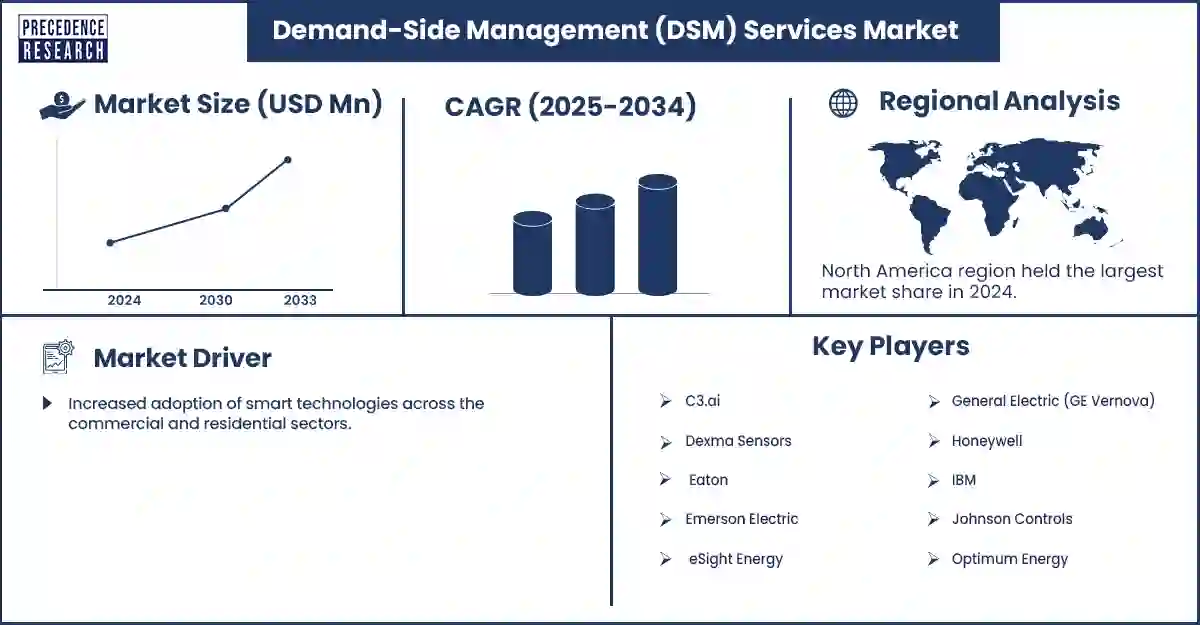Demand-Side Management (DSM) Services Market Revenue and Forecast by 2033
Demand-Side Management (DSM) Services Market Revenue and Trends 2025 to 2033
The global demand-side management (DSM) services market is driven by increasing energy efficiency needs and the adoption of smart grid technologies across industries. Increasing energy needs drive the market, continuous pressure to integrate intermittent renewable energy sources into the grid, and the aim of reducing overload on aging infrastructure and meeting stringent environmental regulations.

What Are the Leading Reasons for the Demand Side Management (DSM) Services Market Growth?
The demand-side management (DSM) services market is driven by a couple of major reasons, including the increasing demand for renewable energy integration due to energy scarcity from conventional energy providers. The grid faces challenges due to its intermittent nature, and demand side management services help by actively adjusting overall energy consumption to match demand and available supply. As wind and solar power continue to expand, DSM becomes essential to prevent grid instability, voltage fluctuations and frequency deviations that occur when renewable generation ramps up or drops suddenly.
Technologies such as grid-scale and residential batteries, along with thermal storage in buildings, hold potential to store excessive energy during low demand periods and discharge it when it is peak demand. This is how DSM optimizes the use of these storage solutions, fuelling the market's growth. DSM platforms use predictive analytics, smart algorithms, and automated controls to shift consumption patterns, charge batteries when renewable generation is abundant and reduce the load during tight supply periods. This directly supports grid flexibility, reduces strain on aging infrastructure and lowers the need for costly peaking power plants. Utilities also rely on DSM programs to improve overall system efficiency, reduce carbon emissions and comply with energy conservation mandates.
Segments Insights
- By service type, the energy efficiency services segment held the largest market share, as energy reduction is a major long-term goal for many enterprises to minimize overall expenses. These services include HVAC optimization, lighting retrofits, building automation, process efficiency improvements and continuous monitoring systems that help industrial, commercial and residential users cut operational costs.
- By solution type, the software and analytics segment dominated the global demand-side management (DSM) services market as they perform a foundational role in the real-time monitoring, load forecasting and automated energy control systems. Advanced DSM software uses predictive algorithms to understand usage trends, recommend load shifting strategies and coordinate energy storage dispatch.
- By end user, the utility companies segment held the largest market share in 2024, due to the grid balancing targets, implementation of large-scale load control and peak shaving, which allows utilities use DSM to override uncertainty over energy supply. Utilities deploy DSM to avoid grid congestion, defer new infrastructure investments and improve service reliability.
- By technology, the smart meters and advanced metering infrastructure held the largest market share due to its potential to deliver precise, real-time energy consumption data which is crucial for forecasting energy changes. AMI systems allow utilities to remotely monitor consumption, detect outages, communicate pricing signals and support time of use tariffs.
Regional Insights
North America held the largest share in the demand-side management (DSM) services market in 2024 and driven by factors like its well-developed energy infrastructure, robust regulatory frameworks and rapid adoption of smart grid technologies. Such widespread deployment enables two-way communication between consumers and utilities, a major benefit of the effective implementation of demand-side management services. Programs such as automated demand response, dynamic pricing and distributed energy resource aggregation are widely implemented in the region.
On a country level, the U.S. and Canada governments have significantly invested into the modernization of the existing grids and expanded their working ability, especially for resilience and innovation. Also, factors like the expansion of smart grid infrastructure, initiatives by authorities to encourage consumers to use energy-efficient technologies along with the integration of IoT, AI and cloud platforms to manage energy utilization, are further expanding the market growth. Federal initiatives such as the U.S. Department of Energy Grid Modernization Program and Canada's Smart Grid Fund continue to accelerate DSM adoption.
The Asia Pacific region is expected to post the fastest growth in the demand-side management (DSM) services market over the upcoming period. Its growth is driven by the whopping energy demand, increasing electricity consumption, aggressive government policies and the growing adoption of advanced energy technologies. Countries in the region are rapidly scaling solar, wind and hydro capacity, which increases the need for flexible DSM solutions to balance variable power output.
Rapid urbanization and excessive rate of industrialization across the leading countries of the Asia Pacific like India, China and Japan, are creating a significant surge in electricity consumption, making it crucial to manage peak loads and prevent power outages. Governments are deploying time-of-day pricing, smart meter rollouts, automated demand response projects and large-scale energy storage systems to reduce strain on electricity networks. Industrial users are also adopting DSM tools to manage operational energy costs and comply with regional efficiency mandates.
Demand-Side Management (DSM) Services Market Coverage
| Report Attribute | Key Statistics |
| Quantitative Units | Revenue in USD million/billion, Volume in units |
| Largest Market | North America |
| Base Year | 2024 |
| Regions Covered | North America, Europe, Asia-Pacific, Latin America, and the Middle East & Africa |
Recent Development
- In November 2025, Out-of-home adtech provider Broadsign unveiled its plan to acquire a leading independent OOH supply-side platform, Place Exchange along with the investment from crestline investors.(Source: https://www.businesswire.com)
Get this report to explore global market size, share, CAGR, and trends, featuring detailed segmental analysis and an insightful competitive landscape overview @ https://www.precedenceresearch.com/sample/7155
You can place an order or ask any questions, please feel free to contact us at sales@precedenceresearch.com |+1 804 441 9344